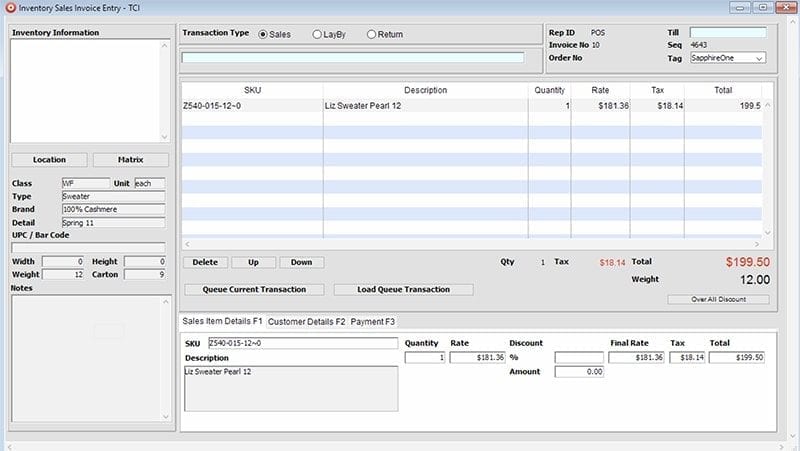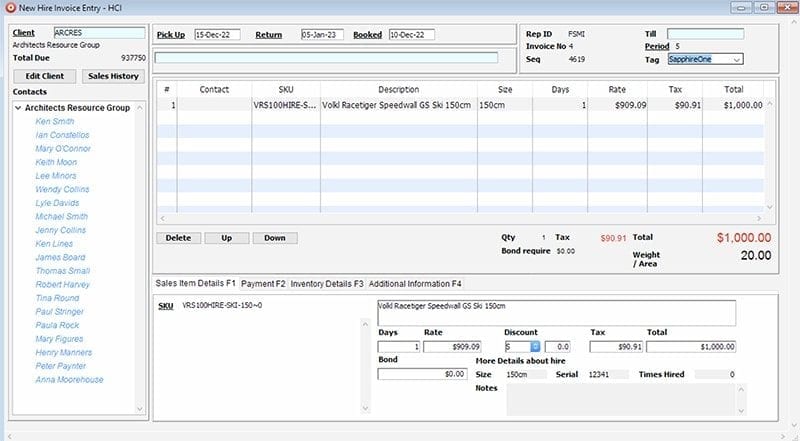Point of Sale - Data Entry
Point of Sale
O
Along with multi-store and multi-till functionality, back office staff can access real-time information of transactions and staff performance for any store. Retail staff can easily process sales, lay-bys, returns and orders directly from an easy-to-use Point of Sale interface. Our Web Pack POS software solution allows staff to enter transactions directly into the system from anywhere on the retail floor through an iPad or android tablet device. Managers can reconcile day-end transactions to check till floats and post directly back into SapphireOne financials.
Users can take advantage of multi-pricing structures for inventory items and SapphireOne’s powerful Pricebook functionality to easily update sale or customer-loyalty pricing. Using a combination of SapphireOne’s CRM and marketing platforms will allow for the creation of sophisticated sales and marketing campaigns which can be targeted at either specific customers or your whole client database.
SapphireOne’s Open to Buy budgeting functionality will allow store owner/buyers complete control over their inventory which is critical to ensuring an adequate level of stock is on hand to meet sales demand.
SapphireOne performs all the features for Point of Sale (POS) transactions and any user with access to the Inventory functions may access POS. Users may can also be set up to allow access to POS only provided they have the correct permissions set in their main user file and, if necessary, also in their Sales Persons user file.
The Point of Sale screen is divided into six main areas – Inventory Details, Transaction Type & Inventory Selection, Tracking, Inventory Line Entries, Customer and Payment Tabs. Each area contains additional information about the Inventory lines and the POS transaction.
Once the ID has been entered the item will immediately be entered into the Inventory Line Entries area and the entry point as seen at the top of the page will be cleared ready for the next item. This area displays the Inventory items as they are added to the customer’s current list of purchases as seen in the picture.
These first three types of transactions, sales, layby and return, are the Invoice entry method for the retail organisation and are selected by choosing the appropriate radio button as seen here when creating the POS transaction.
The system displays the basic stock details on the Details Tab on the left-hand side of the POS window.
The tracking area contains the following information – The Rep ID, The Invoice number, The Order Number, The Till used, and the Sequence Number. There is also provision for the use of a Tag.

SapphireOne performs all the features for Point of Sale (POS) transactions and any user with access to the Inventory functions may access POS. Users may can also be set up to allow access to POS only provided they have the correct permissions set in their main user file and, if necessary, also in their Sales Persons user file.
The Point of Sale screen is divided into six main areas – Inventory Details, Transaction Type & Inventory Selection, Tracking, Inventory Line Entries, Customer and Payment Tabs. Each area contains additional information about the Inventory lines and the POS transaction.
Once the ID has been entered the item will immediately be entered into the Inventory Line Entries area and the entry point as seen at the top of the page will be cleared ready for the next item. This area displays the Inventory items as they are added to the customer’s current list of purchases as seen in the picture.
These first three types of transactions, sales, layby and return, are the Invoice entry method for the retail organisation and are selected by choosing the appropriate radio button as seen here when creating the POS transaction.
The system displays the basic stock details on the Details Tab on the left-hand side of the POS window.
The tracking area contains the following information – The Rep ID, The Invoice number, The Order Number, The Till used, and the Sequence Number. There is also provision for the use of a Tag.
It should be pointed out that this is the only place in the entire SapphireOne system that the Hiring of inventory items is performed. With some minor alterations, Hire is very similar to the standard POS screen. When selecting Hire items from inventory the procedure for selecting them is slightly different as serial numbers for hire items is forced.
This type of transaction is created by the system when an item is Hired rather than sold. Hiring is performed only from the POS drop-down menu.
This type of transaction is created by the system when a Hire Item is returned. The original HCI must be posted first.

It should be pointed out that this is the only place in the entire SapphireOne system that the Hiring of inventory items is performed. With some minor alterations, Hire is very similar to the standard POS screen. When selecting Hire items from inventory the procedure for selecting them is slightly different as serial numbers for hire items is forced.
This type of transaction is created by the system when an item is Hired rather than sold. Hiring is performed only from the POS drop-down menu.
This type of transaction is created by the system when a Hire Item is returned. The original HCI must be posted first.
This function is for the management of payments made by customers for lay-by transactions in the system. A user may either view lay-by payments already made in the system, or receive and process their additional payments as they are received. Lay-by payments are stored in the till that was used to process the lay-by transaction. Selecting the lay-by payment option will cause the system to display a till or a list of tills currently in the system.
Reconciliation is done on a till-by-till basis. When the Reconciliation item is selected, the system will list all tills currently active in the system.
Powerful search functionality to quickly locate inventory items.
Easily check item pricing and stock quantities at various locations at the click of a button.
Scan barcodes to auto-enter item details.
Display photos of items in both search and transaction procedures providing visual verification.
Style/Colour/Size Matrix – easily find available items within the matrix.
Easily allocate % or $ discounts to selected items.
Multiple and mixed payment types (ie cash, cheque, eft, credit card, voucher) can be allocated to transactions.
Queue transactions to allow for faster processing times (if customers go back out to the retail floor to look for more products).
Create and edit customer records on the fly.
Personalise POS interface with pictures or an array of colour pallets – RGB, CMYK, HSB and grey-scale sliders.
Easily access popular items for speedy transactions.
Increase staff productivity by utilising the ability for mobile transaction processes through an iPad or android tablet device.
Store notes on inventory items to help with product knowledge and order processes.
The inquiry screen lists all current POS transactions in numbered sequence. From here both retail and back-office staff can easily check current transactions through a variety of relevant fields. With SapphireOne’s powerful query editor, every transaction can be found and analysed through a variety of different tables and fields. Access security allows managers to make changes if mistakes have been made and also allows for the use of SapphireOne’s document management capabilities.
Shop Inquiry allows the user to set-up various store locations and allocate tills for that store. Here you can allocate inventory locations, start and end dates, and docket messages as well as allocate accounts for cash and merchant facility transactions. If using SapphireOne’s inbuilt soft-phone functionality, users within the group can easily access and call the required store from within the system.
Lay-by Payments provides users with a simple-to-use functionality for processing current lay-by transactions. Lay-by payments can be made using various and mixed payment methods and cancellations can also be easily refunded in part or whole from this screen.
POS reconciliation allows for end-of-day tallies and variances to be recorded for banking purposes.
Post Transactions is a checking procedure which is run on every transaction prior to it affecting the gl. Once a transaction has been “˜posted’, it can no longer be modified. The user has the option to continue processing immediately or send the posting process to the activity queue for processing later. Both options will produce an audit trail of the posting transactions. As a secondary option to posting immediately, you can finish the posting in the background allowing you to continue with data entry.
Dashboards, column-based and graphical reports allow customisation of reporting to your individual requirements.
SapphireOne Point Of Sale has been designed with ease of use in mind. Navigable by mouse or under complete keyboard control, the information that you need to make a quick sale is readily available.
Stock can be entered by scanning the individual barcodes or by manual entry. Once the item code has been entered, a full description of the stock item appears on-screen.
Fields are available to record all the details required for your customer’s preferred payment method.
Receipts can be printed through a thermal receipt printer, by direct print or on standard or custom specifically-designed receipt layouts.
Reconcile daily taking against SapphireOne records.